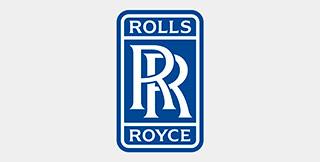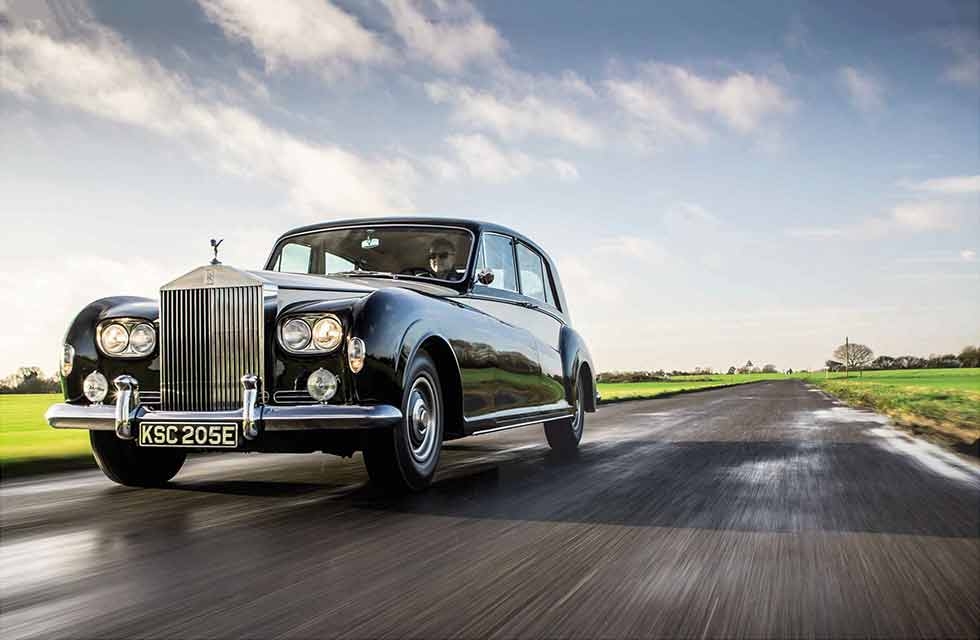
Few limos do luxury and tradition quite like the Rolls-Royce Phantom V. Marque expert Paul Wood explains why every collector should have one. Words Glen Waddington. Photography Charlie Magee.
GRAND LUXE AUTO ROLLS-ROYCE PHANTOM V Why every collector should have one
Its so under-rated/ says Paul Wood, dedicated Rolls-Royce specialist and enthusiast. ‘People think they’re a big clumsy limousine and collectors ignore them. But if you have a collection of Rolls-Royces, you’ve got to have a Phantom V.
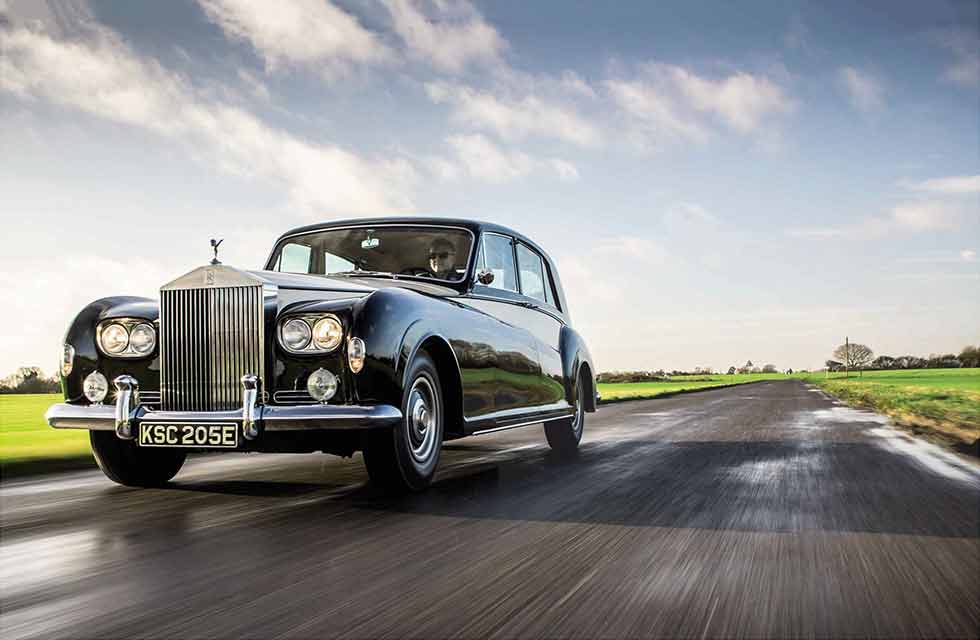
That’s why I’m here in deepest rural Essex close to Christmas on a day when we got lucky with the weather. It’s cold but crisp under huge East Anglia skies amid the kind of landscape that only just manages to give the gargantuan Phantom any human scale. Within, it’s warm and quiet, cosy in the manner of a Georgian drawing room. And Paul is on hand to convince me of its virtues, having called the Octane office to suggest he should do so. this, to his mind, is one of the finest Rolls-Royces made. ‘It is elegance, quality and refinement made real,’ he adds. ‘As a limousine for important people, it’s the absolute pinnacle.’
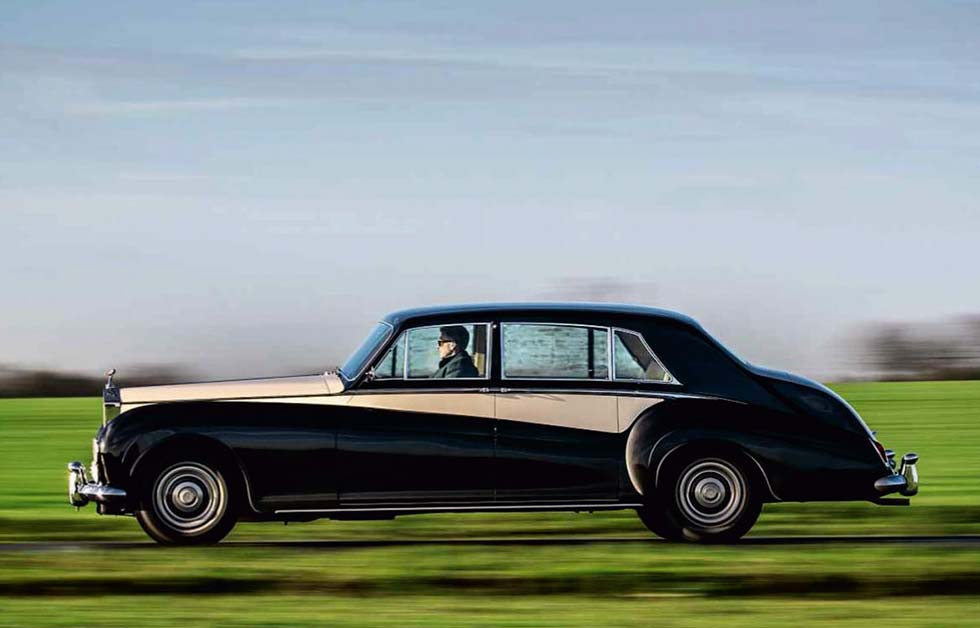
Strong words indeed. Earlier, and notably relaxed in his own environment, Paul had shown me around the premises at P&A Wood, the Rolls-Royce empire he has built up with his brother Andy over more than half a century, the only UK specialist granted the right by Rolls-Royce to carry out accident repairs on its behalf. Coachbuilding is taken seriously here, and strolling the workshops and showrooms is like a personal Rolls-Royce history lesson. Paul knows these cars inside out. He knows every kind of Rolls-Royce in that depth. When he speaks, I listen.
‘The Phantom is refined rather than artificially silenced, bringing to mind the distant stirrings in a luxury hotel’
Today’s plutocrats and despots might buy the latest Phantom, the second designed and built under BMW’s tenure since its 2003 original gave way in 2017. They’re the seventh and eighth generations overall, the Phantom VI was discontinued in 1991, creating an opportunity eventually taken by Bentley to offer a limousine for royal duties. Apart from that gap, and another caused by the hostilities of World War Two, a Phantom has been Rolls-Royce’s most luxurious car since 1925, when it replaced the Silver Ghost.
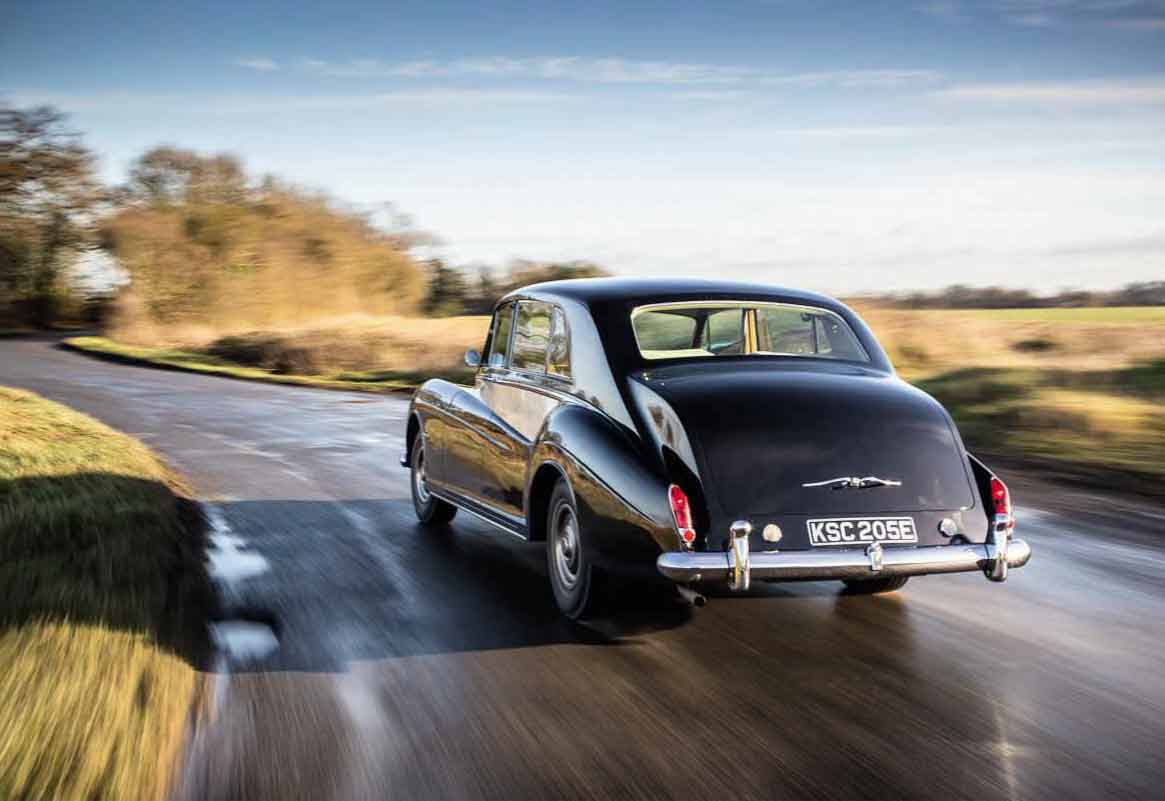
The first two were powered by straight-sixes; the Phantom III (1936-1939) had a V12. Rarest of the line is the post-war Phantom IV of which only 18 were built, based on the straight-eight-powered Silver Wraith (16 still exist). It was deliberately limited in production, to allow the Silver Wraith to cater for business and private customers, then came this car, which carries on the tradition of coachbuilding established by its predecessors yet combines their old-fashioned propriety and exclusivity with modern conveniences such as air-conditioning and electric windows, as well as a burly though smooth and discreet V8. It’s like the Victorians meeting – and accepting – the teachings of Steve Jobs. And it deliberately made available the kind of car usually bought by royalty and heads of state to the merely very rich.

The Phantom V arrived in 1959. According to The Autocar magazine, it was ‘intended to provide really luxurious transport of the type needed in modern business and political circles for important guests and executives, and Rolls-Royce even hint that the vast space they provide may well attract some private buyers who are tired of the physical contortions necessary when entering or leaving the average modern car’.
Comparison with any ‘average’ car is hardly deserved, as the Phantom V is based on the already fairly extraordinary Silver Cloud II. It sits on that car’s cruciform chassis, extended by 21in and strengthened with an extra crossmember, here’s a 6230cc (or ‘6 ¼ ’) V8, newly introduced on the Cloud II, with transmission via a four- speed automatic gearbox (licence-built to a GM design though with an extra-low first – good for parades), which drives the brake servo, the engine copied design features of Cadillac and Chrysler V8s, and that servo was based on Hispano-Suizas idea, ‘they would take the best available and refine it further,’ says Paul. Which seems fair enough.

If there was a standard body, it was the staid-looking seven-passenger limousine built by Rolls-Royce’s own Park Ward subsidiary. Of course, its separate chassis meant the Phantom V could be provided the old-fashioned way, for the owner to have it clad by their coachbuilder of choice.
While there were one-offs from Chapron, Woodall-Nicholson (which built a unique hearse) and others, the most elegant coachwork always came from James Young – and with an overall length greater than 20ft, and a wheelbase of 12ft, chief designer AF McNeil’s talents had room to flow, with a falling waistline that then swells up and over the rear wheels, and a swept tail with bustle boot. And the most elegant of James Young’s work on the Phantom V came late in its career with the application of a ‘Hooper-style’ rear quarter-light, the trailing edge of which follows the roofline and tapers to a point. Hooper-style? It’s named after the rival coachbuilder who’d developed the look on other cars, particularly the Phantom IV.
Such is this Phantom V, so it’s one of the rarer versions of what’s known as a PV23 Touring Limousine. ‘It’s the most elegant of the lot,’ says Paul. ‘You’ll pay £300,000 and more for a good one. they can suffer from corrosion, and that’s more important than anything else. You need to find a car that’s entirely corrosion-free, they exist, but you have to pay for one. Still, it’s a bargain compared with its only real competitor: the Mercedes 600 Pullman. Great, but nowhere near this level of elegance and style.’

In any condition, they aren’t hugely numerous. Of 516 Phantom Vs built during its nine-year career, 196 were bodied by James Young, 125 of those the quad-lamp variety introduced with the Silver Cloud III in 1963.
There are certainly no physical contortions necessary when it comes to getting in or out. the driver’s door swings open weightily yet easily, and you step up onto the running board before taking your place on the broad, flat bench seat. It’s leather-trimmed, as is the majority of the interior, though if you glance rearwards you’ll notice the quarters for those who prefer to be chauffeured are swathed in West of England cloth, the dashboard has the character of a Chippendale sideboard, with instruments grouped across the centre (in typical Rolls-Royce style, there’s no revcounter). It’s not so much a nod to tradition as tradition itself.
Pull the door shut and it latches accurately with a tight kah-lunk. Then fire the V8 and it woofles into life, audibly but unobtrusively, here’s a delicate, wand-like transmission selector protruding from the steering wheel, with no Park position, so you move it from ‘N’ into ‘A’, release the umbrella-handle parking brake and ease away gently on the throttle.
The Phantom feels big, its substantial length on your mind as you manoeuvre. Yet it is never unwieldy, and neither does it feel heavy, the power-assisted steering is light but there’s no slack, and you soon get used to guiding this leviathan on your fingertips while torque pours out of the V8 from barely above idle speed. Soon you’re at a cruise, the gearbox having shifted itself smoothly to match. It’s not silent like a hermetically sealed modern luxury car such as the latest Phantom, but it is mechanically quiet, refined rather than artificially silenced, bringing to mind the distant stirrings in a luxury hotel or your awareness of the propulsion on board a cruiseliner. And it’s just as relaxing.
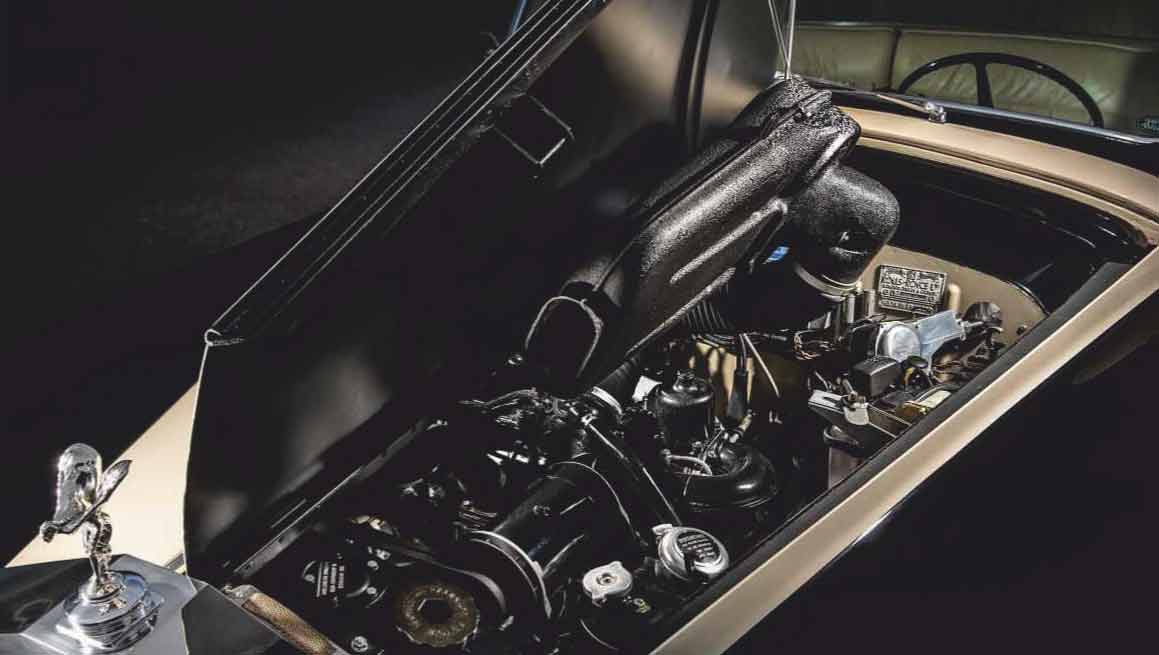
Mention of a cruiseliner is appropriate. Something about the character of the Phantom V calls to mind one of the great ships, even the era of traversing the Atlantic under steam to be welcomed into a city eager to leave behind the era of the Great Depression without deserting those who’d appreciate modernity less, the kind of people who’d sit in the back of one of these, reading the broadsheets while the chauffeur takes care of motion.
Appropriately, Paul once delivered a Phantom V to New York. ‘We travelled over on the QE2,’ he recalls with a smile. ‘I’d sold the car to Woody Allen. He was very enthusiastic about the whole thing.’
I brake for a corner, aware that there’s quite some mass to arrest, but only at parking speeds can you occasionally be caught out: the gearbox-driven servo needs at least one wheel revolution to attain full power. So you just press harder, these brakes are effectively failsafe.
There’s delicate feedback through the slender Bakelite rim of the steering wheel and yes, the car rolls, but it does so gently and you tend to move with it rather than rock about within it. Perhaps it’s the Phantom Vs weight or the over-scale proportions of its body, but it seems to slow down time and temper gravity.
Most would appreciate it from the back seat, so I pull over and Paul takes the wheel while I tug the rear-hinged door (the dainty square release buttons are pure James Young) and settle back into the warm, comfy sofa. It’s like something from an old theatre, with pronounced shoulder support and cosseting springs: bolstering yet soft, and also mobile rather than foamy and dead.

Paul picks up speed and for the first time I notice the ride – because I’m concentrating on it. While driving, the road surface had simply slipped beneath the wheels. Now I’m aware of the gentle, loping motion as the body pitches, and the way all surface harshness is rounded away. Bumps never feel sudden but there is always movement. It brings to mind that cruiseliner again: very comfortable, very characterful; a nice place in which to spend time, gather distance and arrive.
The view out is striking: an acreage of windows uninterrupted by metalwork, in stark contrast to the privacy glass and car-swallowing pillars of the current Phantom. And there’s the cabinetry, so beautifully executed. I keep the division open so I can exchange opinions with Paul, but it would rise at the touch of a button, sealing the owner away from his employee.
We pull up again at the P&A Wood premises and take a few moments to walk around the car, admiring the impeccable shutlines: a James Young hallmark and all the more remarkable as this car is more than 50 years old and has never been apart. Paul is in charge of coachwork here and, though he gets little chance to be hands-on these days, not much escapes his seasoned eye. ‘The quality of the coachwork, the panel fit, the way the doors close… Inside, the veneers, the way they follow all the way round the cabin, the way the cocktail cabinet fits and how the picnic tables lift and shut… the quality is amazing.’
All the handles, catches and buttons are to a distinctive James Young style, whose business is endearingly labelled as hailing from Milan, Turin and… Bromley, ‘that rear quarter window is my favourite element of its style, but I also love those cocktail cabinets, and the folding jump seats. It’s actually quite a practical, usable car.’

So why don’t more people rate them? ‘Cere’s a belief that they’re clumsy on the road, but that’s all down to how they’ve been set-up,’ says Paul, this is clearly a good example, then, as it feels taut despite its obvious comfort – and in spite of its prosaic running gear, with a leaf- sprung live axle and drum brakes.
‘It sounds ordinary, but the quality of componentry is like you wouldn’t believe. And there’s nothing flash: it’s all enamelled black under the bonnet, and that’s also where the actuators are for the electrically controlled heating system. In that respect it was very advanced.’
Paul’s brother Andy rescued the damper testing machine from the Crewe factory when Silver Shadow production began – ‘the engineers had improved it for their own purposes’ – and then restored it, so it’s used to set-up the complex lever-arm assemblies on these cars. As for brakes and steering, both are difficult to get ‘spot- on’: it’s down to ‘skilled workmen with the patience to get it right to the nth degree’, he says.
The final Phantom V (a Park Ward Limousine) was delivered in September 1967 to Rolls-Royce Sales in London’s Conduit Street for use as a demonstrator, before going back to the experimental department for conversion to a Phantom VI, production of which duly followed in 1968. Yet fewer were produced in spite of its 23-year span. All but eight were, in effect, built in-house: HJ Mulliner had been taken over by Park Ward, already part of Rolls-Royce, and James Young – last of the independents to build Rolls-Royce bodies – had gradually foundered.
The newly named Mulliner Park Ward built 346 limousines, 12 landaulettes and a handful of specials, while the remainder of the 374 total included several hearses plus, by Frua, a one-off drophead coupe that clearly influenced the Rolls-Royce Camargue and an equally unique cabriolet on a 1971 chassis that was finally completed by British coachworks Royle Cars in 1993. By 1972, US federal safety standards meant the Phantom VI could no longer be sold there, even though the rear passenger doors had by then become forward-hinged.
‘The Phantom VI just wasn’t as special,’ says Andy, ‘they were basically Phantom Vs converted to take the Silver Shadow components.’ Tellingly, only 67 were built in the final 13 years of production.
No, if you want real grace to go with all that tradition, plus the power and refinement of a more modern era, a James Young Phantom V is the way to go. In Paul’s words: ‘this is the best coachbuilt luxury car made since World War Two.’ Enough said.
TECHNICAL DATA FILE SPECIFICATIONS 1966 Rolls-Royce Phantom V Touring Limousine by James Young
Engine 6230cc OHV V8, two SU HD8 carburettors
Max Power 200bhp @ 4800rpm (officially not disclosed)
Max Torque 322lb ft @ 2200rpm (officially not disclosed)
Transmission Four-speed automatic, rear-wheel drive
Steering Power-assisted cam and roller
Suspension Front: double wishbones, coil springs, double-acting lever-arm dampers, anti-roll bar. Rear: live axle, semi-elliptic leaf springs, adjustable lever-arm dampers
Brakes Drums, servo driven by gearbox, all hydraulic with mechanical back-up at rear
Weight 2540kg
Performance
Max Speed 120mph (officially not disclosed)
0-62mph 10sec (officially not disclosed)

